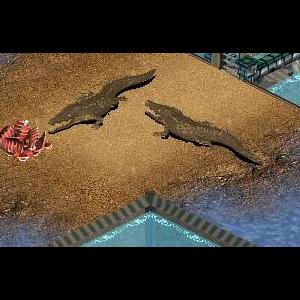About This File
Sarcosuchus meaning 'flesh crocodile' and commonly called "SuperCroc", is an extinct genus of crocodile.
It dates from the early Cretaceous Period of what is now Africa and is one of the largest giant crocodile-like reptiles that ever lived. It was almost twice as long as the largest modern crocodile and weighed up to 10 times as much.
Until recently, all that was known of the genus was a few fossilised teeth and armour scutes, which were discovered in the Sahara Desert by the French paleontologist Albert-Félix de Lapparent, in the 1940s or 1950s. However, in 1997 and 2000, Paul Sereno discovered half a dozen new specimens, including one with about half the skeleton intact and most of the spine. All of the other giant crocodiles are known only from a few partial skulls, so which is actually the biggest is an open question.
When fully mature, Sarcosuchus is believed to have been as long as a city bus (11.2–12.2 meters or 37–40 ft) and weighed up to 8 tonnes (8.75 tons). The largest living crocodilian, the saltwater crocodile, is less than two-thirds of that length (6.3 meters or 20.6 ft is the longest confirmed individual) and a small fraction of the weight (1,200 kg, or 1.3 tons).
The very largest Sarcosuchus is believed to have been the oldest. Osteoderm growth rings taken from an 80% grown individual (based on comparison to largest individual found) suggest that Sarcosuchus kept growing throughout its entire 50–60 year average life span (Sereno et al., 2001). Modern crocodiles grow at a rapid rate, reaching their adult size in about a decade, then growing more slowly afterwards.
Its skull alone was as big as a human adult (1.78 m, or 5 ft 10 inches). The upper jaw overlapped the lower jaw, creating an overbite. The jaws were relatively narrow (especially in juveniles). The snout comprises about 75% of the skull's length (Sereno et al., 2001).
The huge jaw contained 132 thick teeth (Larsson said they were like "railroad spikes. The teeth were conical, adapted for grabbing and holding; instead of narrow, adapted for slashing (like the teeth of some land-dwelling carnivores), and more like that of true crocodilians. Sarcosuchus could probably exert a force of 80 kN (18,000 lbf) with its jaw, making it very unlikely that prey could escape.
It had a row of bony plates or osteoderms, running down its back, the largest of which were 1 m (3 ft) long. The scutes served as armour and may have helped support its great mass, but also restricted its flexibility.
Sarcosuchus also had a strange depression at the end of its snout. Called a bulla, it has been compared to the ghara seen in gharials. Unlike the ghara, though, the bulla is present in all Sarcosuchus skulls that have been found so far. This suggests it was not a sexually selected character (only the male gharial has a ghara). The purpose of this structure remains enigmatic. Sereno and others asked various reptile researchers what their thoughts on this bulla were. Opinions ranged from it being an olfactory enhancer to being connected to a vocalization device.



Recommended Comments
There are no comments to display.
Create an account or sign in to comment
You need to be a member in order to leave a comment
Create an account
Sign up for a new account in our community. It's easy!
Register a new accountSign in
Already have an account? Sign in here.
Sign In Now